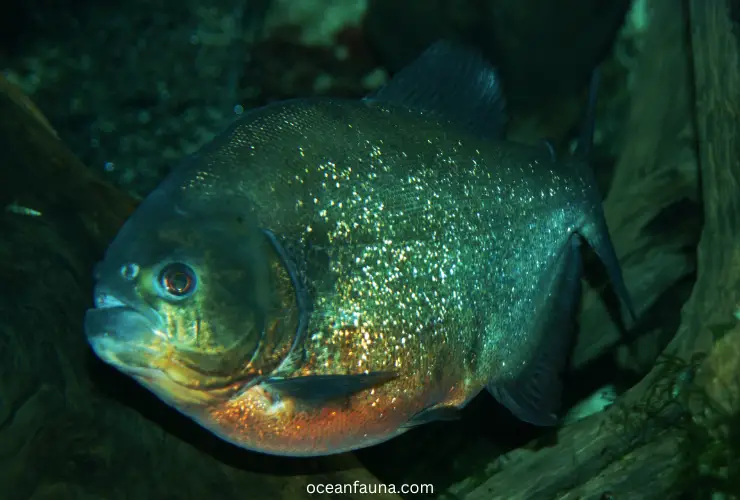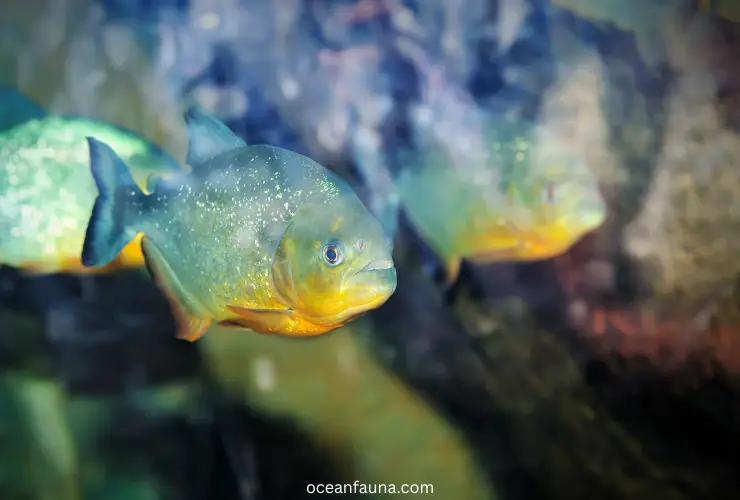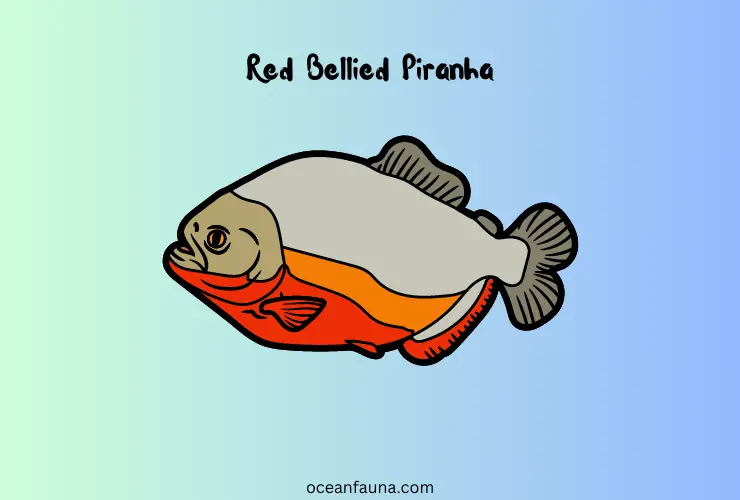Red Bellied Piranha is an intriguing fish species found in the rivers and streams of South America. They have distinct red bellies that contrast with their silver bodies. They have a reputation for being ferocious killers.
But in reality, they are opportunistic feeders that will only attack humans or other large animals in rare circumstances.
You may have heard that these fish are water monsters, but don’t be too quick to judge them! Yes, they have powerful jaws and razor-sharp teeth that are perfect for tearing flesh, but there’s more to them than just their fearsome reputation.
In truth, red-bellied piranhas are a vital part of their ecosystem. They have a unique set of adaptations that allow them to survive in some of the most challenging environments on the planet.
They also have impressive hunting skills that are worth getting to know. So, if you’re interested in uncovering the Red Bellied Piranha’s secrets, keep reading!
About Red Bellied Piranha – A Quick Biology
Let’s take a quick look at this prominent species.
| Parameters | Details |
| Scientific name | Pygocentrus nattereri |
| Kingdom | Animalia |
| Family | Serrasalmidae |
| Genus | Pygocentrus |
| Phylum | Chordata |
| Class | Osteichthyes (bony fish) |
| Order | Characiformes |
| Species | P. nattereri |
| Habitat | Freshwater rivers |
| Life Span | 10 years and more |
| Diet | Fish, insects, mollusks, crustaceans and plants |
| Geography | South America |

Geographic Distribution of Red Bellied Piranha
A study shows red-bellied piranhas are found in many parts of South America. They love living in freshwater rivers and streams where the weather is tropical, and the temperatures are warm. You can find them thriving in the following countries.
- Argentina
- Bolivia
- Brazil
- Ecuador
- Colombia
- Guyana
- Peru
- Paraguay
- Uruguay
- Venezuela
The Amazon River, in particular, is home to a large population of these fish.
Appearance of Red Bellied Piranha
The red-bellied piranha has a distinct appearance. It is defined by its striking red undersides, extending from its chin and cheeks to its belly. Its profile is snub-nosed and rounded, while its head and body are adorned with shades of gray. The sides of its body have bright silver scales. These fish can reach 30 to 50 cm in length in the wild.
But that’s not all that makes the red-bellied piranha unique. These fish have sleek, streamlined bodies built for speed and agility in the water. They have strong muscles that connect to a short and stout lower jaw.
Perhaps the most notable feature is their sharp, triangular teeth, which are ideally suited for tearing apart prey. These teeth are usually concealed behind thick, fleshy lips, but they’re definitely not something you’d want to mess with!
If you were to get up close and personal with a red-bellied piranha (which we don’t recommend!), you’d also notice its large, expressive eyes, which are perfectly adapted for low-light conditions.
Behavior of Red Bellied Piranha
Social Behavior
Red-bellied piranhas are highly social. They swim in groups called shoals that can number over 20 individuals. During the day, smaller piranhas forage for food, while larger ones are more active at dawn and dusk.
If they sense danger, they’re quick to make their presence known with various sounds, such as grunts, barks, and drumming. They’ll launch a fierce counterattack against the predator if the threat persists.
Territorial Behavior
But beware; red-bellied piranhas can also display territorial behavior, and they aren’t afraid to defend their breeding sites from other fish. When threatened, they may attack other fish that come too close, revealing their fierce nature and dedication to protecting their young.
Habitat And Range of Red Bellied Piranha
Concerning their habitat, red-bellied piranhas prefer whitewater areas, which are spots with a neutral PH level. They also like water that’s between 59 and 95°F.
However, some piranhas have been seen in blackwater regions, which are highly acidic zones of rivers and streams. These formidable fish have even been known to survive in water temperatures that are less than 50 °F.
Apart from living in major river systems and streams, red-bellied piranhas can also be found in various lakes, floodplains, and flooded forest regions of South America. However, they mainly inhabit low-elevation areas of the Amazon River, with a clear preference for fast-moving water segments. Also, some of these creatures can be found in the coastal area of the Atlantic.

Feeding/Diet- Are They Omnivorous Or Carnivorous?
Red-bellied piranhas are omnivores. Their favorite foods include figs, shrimp, insects, snails, plants, and seeds. They will even eat small animals and birds roaming too near their nesting grounds.
When the opportunity arises, they may also eat earthworms and crustaceans. However, piranhas may band together to hunt larger animals, such as the Capybara. Interestingly, a significant portion of the piranha’s diet consists of small bits of fins that they nip off of larger fish as they swim by.
Do they hunt as a team?
Though red-bellied piranhas usually live together in groups, they don’t usually hunt as a team. Instead, they prefer to hunt and eat their prey alone. This means that it’s rare to see a feeding frenzy where all the piranhas in the group go after their food at the same time.
However, if there’s not enough food around or they’re starving, red-bellied piranhas have been known to work together to attack and eat large prey. When they do this, it can happen really quickly, with the piranhas devouring their victim in just a few minutes.
Reproduction of Red Bellied Piranha
Red-bellied piranhas breed during the rainy season when water levels are high. Males will dig shallow nests in the riverbed and try to attract females by grunting.
The female lays up to 5,000 eggs at a time in the nest. They will lay their eggs in the nest, where the male will fertilize them. After fertilization, the egg attaches to the plants at the bottom of the water.
So, who takes care of the baby?
Piranha eggs hatch very quickly, usually within just two to three days. When their babies are born, they’re really small and can easily be attacked by larger predators.
For instance, sometimes bigger fish like characids might try to hunt the baby piranhas when the nest is left unguarded for a short time. To keep them safe, male piranhas swim around the nest in circles occasionally until the babies are strong enough to swim on their own.
Predators of Red Bellied Piranha
Although piranhas are notorious for their aggressive nature, they’re not always the top predator in their habitat. In the Amazon, they can become prey for various other animals.
According to the marine research journal, larger predatory fish such as river dolphins, crocodiles, caimans, and birds like storks, turtles, and egrets may hunt the red-bellied piranha. In addition, even other piranhas can eat their own kind, making the Amazonian waters dangerous for these toothy fish.
Human Usage of Red Bellied Piranha
Anglers frequently catch red-bellied piranhas to use as bait for larger fish. However, you might be surprised to know that piranha flesh is more than just bait for indigenous people living in the Amazon River.
In fact, it’s a delicacy in many parts of South America! These people have been known to consume piranha meat for generations, considering it a tasty and nutritious addition to their diets. The meat is said to be particularly delicious when grilled, and piranha soup is also a popular dish.
Population of Red Bellied Piranha
There’s not much information about the exact number of these fish in the world. The organizations IUCN, CITES, and USFWS do not consider them in danger of becoming extinct. Currently, they are classified as having a low risk of endangerment.
Fossil Records of Red Bellied Piranha
According to a BBC News article, researchers have uncovered the fossilized remains of a species similar to piranhas. They consider it the earliest evidence of a flesh-eating fish. This bony creature was found in South Germany and lived during the Late Jurassic period, approximately 150 million years ago.
However, it is still being determined if this species is directly related to the modern red-bellied piranha (Pygocentrus nattereri) found in South America today. Further research is necessary to assess the evolution of the red-bellied piranha and its ancient ancestors.

Is Piranhas Dangerous? Aggression in Nature And Aquarium
We’ve all heard scary stories about piranhas. But are they really the aggressive, man-eating creatures that movies and books make them out to be?
Piranhas have long been portrayed as ferocious predators, but recent scientific studies have helped dispel myths surrounding these freshwater fish.
In reality, red-bellied piranhas, the most common type of piranha, are not as dangerous to humans as you think. While they have sharp teeth and powerful jaws, but are cautious and timid. Many people have swum safely in waters where piranhas were present.
They live in groups, not because they hunt for humans. Instead, they stay in groups to protect themselves from larger predators and are lower on the food chain. While they can be ferocious hunters of smaller fish, they are not generally a threat to larger animals.
However, there are situations where piranhas might become aggressive toward humans or other animals. This can happen during dry seasons when food is scarce or during spawning periods when they are defending their nests. But such cases are rare. So, they are not the man-eating monsters that popular culture sometimes portrays them as.
Can You Eat Red-Bellied Piranhas? What Do They Taste Like?
Yes, you can eat red-bellied piranhas. Although it may sound bizarre to think of eating such dangerous creatures, some people consume them as food. In fact, they are appreciated for their culinary value by many who call the Amazon region home.
Recent research has shown that piranhas are an excellent source of omega-3 and omega-6 fatty acids and other essential nutrients. The flesh of piranhas is white, firm, and flaky, similar to other freshwater fish. They taste “very fishy” and “a little ripe.”
The best way to prepare it is by grilling or smoking it to reduce the fishy taste and odor. However, due to their reputation as fierce predators, many people still hesitate to eat piranhas or consider them delicacies.
Has a Human Ever Been Killed by Piranhas?
According to research published at PubMed, while there have been reports of piranhas consuming human flesh, most of these cases involved victims who were already deceased, such as drowning victims.
In fact, it would take around 500 piranhas to consume an average-sized human (weighing 180 pounds) in just five minutes. The typical group of piranhas, or shoal, consists of around 20 fish, so the threat to humans is relatively low.
FAQs
Does a Piranha Bite Harder Than a Great White Shark?
Researchers have conducted various studies to compare the bite forces of piranhas and great white sharks. A study published in 2012 found the bite force of a piranha to be 72 pounds per square inch (320 Newtons) at the front of its mouth.
In contrast, computer models generated from CT scans of shark skulls suggest that the bite force of a great white shark is almost 4,000 pounds per square inch (PSI).
Despite the great white shark having a much stronger bite force than the piranha, its bite is still impressive, given its size. Piranhas can apply a pressure of up to 30 times their body weight. On the contrary, great white sharks have an anterior bite force of about 0.3 times their body weight.
Does Piranha Eat Bones?
No, piranhas don’t eat bones. They have strong jaws and sharp teeth that are well-suited for tearing apart flesh but not for crushing bones. While it’s true that piranhas have been known to strip the flesh from bones, they typically leave the bones behind once they have consumed all the meat.
Do Piranhas Eat Fellow Piranhas?
Yes, when food is scarce, piranhas may resort to cannibalism and feed on weaker or injured members of their own species. This behavior is more common in captivity or when the piranhas are stressed due to overcrowding or lack of food.
Do Piranhas Live in Saltwater?
No, Piranhas do not live in saltwater. They are exclusively freshwater fish and cannot survive in saltwater environments. In fact, if piranhas were placed in salt water, they would quickly become stressed and eventually die.
Do Piranhas Swim Fast?
Yes, piranhas are known to be fast swimmers. Their bodies are agile and streamlined, letting them move quickly through the water. Piranhas have been known to reach speeds of up to 25 miles per hour when chasing prey or trying to escape danger.
Their speed and agility are essential adaptations for survival in their natural habitat, where they need to catch prey quickly or avoid becoming prey themselves.
Conclusion
The red-bellied piranha is not a water monster but a fascinating and often misunderstood fish that plays a vital role in its ecosystem.
While they have sharp teeth and a reputation for being aggressive, they are not typically a threat to humans unless provoked or hungry. They are an important food source for many other fish and wildlife species.
But wait—there’s more to these mysterious fish. Did you know red-bellied piranhas are not actually red-bellied when they are born?
Instead, they are a silvery color and only develop their distinctive red-orange belly as they mature. They are also recognized for their ability to communicate with each other through sounds made by their swim bladders.

